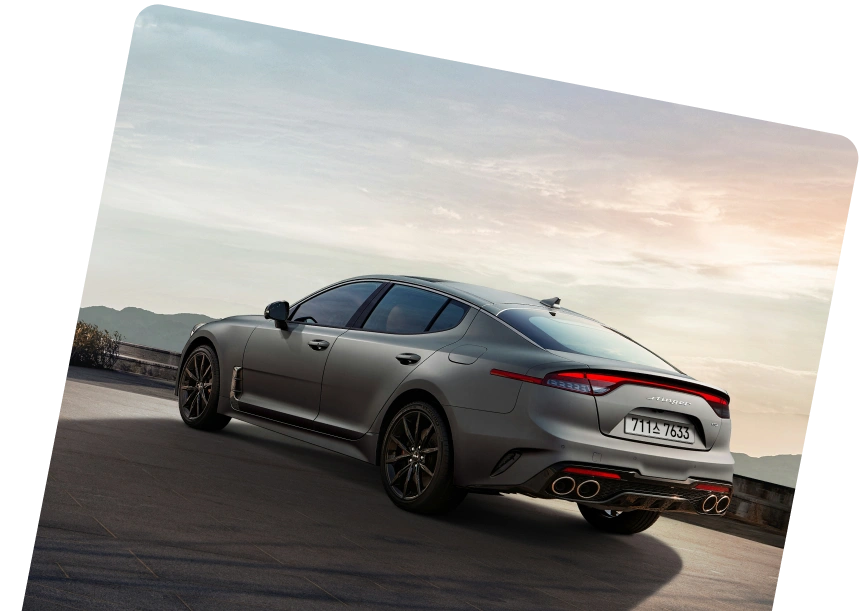Are you considering a used SUV car? You’ve probably come across the Ford Puma and Ford Kuga, both trendy models. The Puma even claimed the title of the UK’s best-selling vehicle last year. This popularity alone makes a strong point for the Puma, but the Kuga also offers benefits for its owners.
Both models are solid choices, each excelling in different features. Let’s compare Ford Kuga vs. Puma to see which suits your needs best.
Performance

Ford Kuga
The Ford Kuga offers a range of engines so that a range of drivers can find what they’re looking for. 1.5-litre and 2.5-litre petrol engines are available, along with a mild and plug-in hybrid. The 1.5-litre petrol produces 147bhp. The 2.5-litre plug-in hybrid can run 30-40 miles on electric power alone and accelerates from 0 to 62mph in 8.5 seconds.

Ford Puma
Ford’s range isn’t as generous when it comes to the Puma. The Puma is only available with 2.1-litre engines producing either 123bhp or 153bhp, with a mild-hybrid version for improved fuel economy in traffic. The Puma’s average 0-62mph time is 8-9 seconds.
The Ford Puma ST is another story. It comes with either a 1.5-litre turbo three-cylinder engine with 197bhp or a newer 168bhp 1.0-litre Powershift version with mild-hybrid technology. The 1.5-litre engine is powerful at low revs and reaches 62mph in 6.7 seconds.
Price
A new Ford Kuga costs several thousand pounds more than a Puma. However, this price difference shrinks a lot on the used market. Used Kugas are just a couple of thousand pounds more than a similarly aged and high-spec Puma, sometimes even closer.
The WLTP fuel consumption for the Ford Kuga is 42.2 mpg, while the Puma combined is more efficient at 44.8 mpg. This difference adds up over time. According to Ford’s comparison tool, the estimated annual ownership costs are £1,911 for the Kuga and £1,438 for the Puma, which means a 24% saving with the Puma.
Styling
Despite both being Ford SUVs, the Ford Puma and Kuga have distinct designs. The Kuga is a larger, more mature-looking SUV with sharp lines, Ford’s signature mouth-shaped grille, and curved LED headlights. Its alloy wheels range from 18 to 20 inches, depending on the trim.
In contrast, the Puma is a small SUV with a fun and quirky appearance. It features distinctive ‘frog-eye’ headlights, a curved design reminiscent of the discontinued first-generation Puma sports coupé, and stylish 19-inch alloy wheels. The Puma’s exterior balances aesthetics with functionality, which makes it a standout in its class.
Overall, both cars are easily distinguishable — the Ford Kuga’s design is more grown-up and refined, whereas the Puma’s playful look appeals to those who appreciate a sportier and more unique style.
Driving
The Ford Puma is great for city driving with light steering and a slightly notchy gear change, which makes it easy to handle. It also has a tight turning circle that’s perfect for urban manoeuvres. However, the ride is firm, especially in ST-Line models with stiffer suspension.
On the motorway, the Puma is decently quiet and performs well with its turbo engine. On twisty roads, it excels with its aggressive feel, although the ride can be bumpy on uneven surfaces, just like in town.
Around town, the Ford Kuga provides a comfortable ride. The brakes can feel a bit sensitive at low speeds, so they need careful use. Unlike the Puma, the Kuga’s suspension handles bumps well. If your area has a lot of corners and twists, the Kuga feels agile and stable. Initially, its steering feels different, returning to the centre more strongly than in some SUVs.
On the motorway, wind and road noise are well-controlled. If you do a lot of driving, know that hybrid models offer quicker acceleration but produce more engine noise under hard acceleration due to the CVT gearbox.
Interior
Ford’s cabin design is practical but not very exciting. Both the Ford Puma and Kuga have a similar layout, with a central infotainment screen, a few shortcut buttons, a volume knob, and physical controls for the heater and A/C. However, the extensive use of black and dark surfaces makes the interiors feel a bit dull.
On the bright side, the ergonomics are great. Key functions have proper knobs and buttons, making them easy to use while driving. Choosing a higher-end trim like the sporty ST-Line can improve the cabin’s look because it adds part-leather seats with red stitching for a bit of flair.

Ford Puma
In terms of the driving position, all Ford Puma trims offer comfortable driver’s seats. The Titanium trim could use more side support, but the ST-Line versions fix this with thicker bolsters.

Ford Kuga
The Ford Kuga gives SUV fans a high driving position. The driving seat is supportive and adjustable, with lumbar support available on all trims, along with ample steering wheel adjustments.
Technology
Both the Puma and the Kuga feature Ford SYNC 3 infotainment system with an 8-inch display (in standard models) and support for Apple CarPlay and Android Auto. Both offer uninterrupted smartphone integration and various pre-installed apps.
The Kuga enhances this experience with a larger 13.2-inch touchscreen and a 12.3-inch display panel in higher trims. These help you change driver aid preferences, sound settings, and onboard Wi-Fi. In comparison, the Puma comes with a more compact dashboard that combines a touchscreen and physical buttons for easy control.
As for other tech features in the Ford Puma:
- Ford Co-Pilot360 for advanced driver assistance
- Ford Pass Connect and emergency assistance
- Adaptive cruise control
- Emergency steering assist
- Driver impairment monitor
Ford Kuga:
- Service interval indicator
- 5G modem & Ford Pass Connect
- Lane-keeping and departure alerts
- Traffic sign detection
- Blind spot alert
- Ford Easy Fuel
Boot space and practicality
The Puma’s boot space is 456 litres. It’s square-shaped with a manageable loading lip, tie-down points, bag hooks, and a 12V socket. The rear seats split and fold in a 60:40 ratio, which expands cargo to 1,216 litres. The Puma also includes an 80-litre compartment under the boot floor called Megabox.
The front cabin is practical, with good storage near the gear lever and three cup holders. In the rear, the seats are cramped, adequate for two adults but uncomfortable for three. It could fit three children, but fitting bulky child seats will be challenging.
The Kuga’s boot offers 526 litres of space with the rear seats up (475 litres in the plug-in hybrid model). It features a flush floor for easy loading, four tie-down points, and remote handles to fold down the rear seats. With the second row folded, the cargo capacity expands to 1,603 litres.
The Ford Kuga has a lot of storage with large door pockets, two cupholders, and a phone tray. Rear-seat access is easy with wide doors, and there’s space for rear-facing child seats. Three adults fit comfortably, even with the optional panoramic sunroof.
Safety and reliability
Both the Ford Kuga and Ford Puma have solid credentials. The Kuga achieved a full five-star rating in Euro NCAP crash tests, so there’s no doubt about its robust safety features. Meanwhile, the Puma scored four stars. This is partly due to stricter testing criteria introduced after the Kuga’s assessment.
Reliability is expected to be excellent for both models. They benefit from shared components across Ford’s lineup, guaranteeing durability from engines to seating. Should any issues arise, rest assured that parts are widely available, and Ford dealerships provide reliable support.
Dimensions
The Puma offers a more compact size, which makes it easier to manoeuvre in tight urban spaces. On the other hand, the dimensions of the larger Kuga contribute to its spacious interior and slightly larger boot space.
Puma
- Length: 4,207 mm
- Width: 1,805 mm
- Height: 1,537 mm
Kuga:
- Length: 4,614 mm
- Width: 1,883 mm
- Height: 1,666 mm
Who is the Ford Kuga for?

Ford Kuga
The Ford Kuga is suited to families who prioritise spaciousness and practicality. It appeals to parents and guardians who need ample room for children, pets, and groceries, whether it’s for daily errands or weekend getaways. The model is also attractive for outdoor enthusiasts who enjoy camping, skiing, or towing trailers for leisure activities.
Who is the Ford Puma for?

Ford Puma
The Ford Puma is tailored for individuals who appreciate a stylish yet practical compact vehicle. It’s perfect for city dwellers who navigate bustling streets and prefer a smaller footprint for parking ease. The Puma is ideal for young professionals or couples who value versatility for both commuting and weekend adventures. The sportier Puma ST variant appeals to drivers who seek spirited performance and enjoy spontaneous road trips.
Final words: Kuga or Puma? Your best option
If you’re still torn between the Ford Puma vs. Ford Kuga, here’s a quick guide to help you decide:
- Choose the Puma if you’re looking for a blend of funky design and practicality that accommodates up to five people. The Puma ST is particularly appealing to driving enthusiasts.
- Alternatively, opt for the Ford Kuga if you have a larger family and need enhanced practicality. It offers sensible driving capabilities and is equipped with four-wheel drive, which makes it suitable for towing.
Both models offer stylish designs, practical features, and affordable pricing, so either is a great choice, whichever way you lean.
Table of Contents








